Copper transporter 2 regulates endocytosis and controls tumor growth and sensitivity to cisplatin in vivo
- PMID: 20930109
- PMCID: PMC3014285
- DOI: 10.1124/mol.110.068411
Copper transporter 2 regulates endocytosis and controls tumor growth and sensitivity to cisplatin in vivo
Erratum in
- Mol Pharmacol. 2011 May;79(5):894-8
Abstract
Copper transporter 2 (CTR2) is one of the four copper transporters in mammalian cells that influence the cellular pharmacology of cisplatin and carboplatin. CTR2 was knocked down using a short hairpin RNA interference. Robust expression of CTR2 was observed in parental tumors grown in vivo, whereas no staining was found in the tumors formed from cells in which CTR2 had been knocked down. Knockdown of CTR2 reduced growth rate by 5.8-fold, increased the frequency of apoptotic cells, and decreased the vascular density, but it did not change copper content. Knockdown of CTR2 increased the tumor accumulation of cis-diamminedichloroplatinum(II) [cisplatin (cDDP)] by 9.1-fold and greatly increased its therapeutic efficacy. Because altered endocytosis has been implicated in cDDP resistance, uptake of dextran was used to quantify the rate of macropinocytosis. Knockdown of CTR2 increased dextran uptake 2.5-fold without reducing exocytosis. Inhibition of macropinocytosis with either amiloride or wortmannin blocked the increase in macropinocytosis mediated by CTR2 knockdown. Stimulation of macropinocytosis by platelet-derived growth factor coordinately increased dextran and cDDP uptake. Knockdown of CTR2 was associated with activation of the Rac1 and cdc42 GTPases that control macropinocytosis but not activation of the phosphoinositide-3 kinase pathway. We conclude that CTR2 is required for optimal tumor growth and that it is an unusually strong regulator of cisplatin accumulation and cytotoxicity. CTR2 regulates the transport of cDDP in part through control of the rate of macropinocytosis via activation of Rac1 and cdc42. Selective knockdown of CTR2 in tumors offers a strategy for enhancing the efficacy of cDDP.
Figures
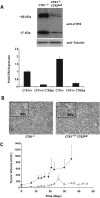
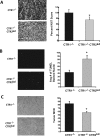
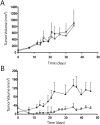
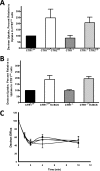
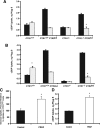

Similar articles
-
Copper transporter 2 regulates the cellular accumulation and cytotoxicity of Cisplatin and Carboplatin.Clin Cancer Res. 2009 Jul 1;15(13):4312-21. doi: 10.1158/1078-0432.CCR-09-0311. Epub 2009 Jun 9. Clin Cancer Res. 2009. PMID: 19509135 Free PMC article.
-
Copper transporter 2 regulates intracellular copper and sensitivity to cisplatin.Metallomics. 2014 Mar;6(3):654-61. doi: 10.1039/c3mt00331k. Epub 2014 Feb 13. Metallomics. 2014. PMID: 24522273 Free PMC article.
-
Regulation of copper transporter 2 expression by copper and cisplatin in human ovarian carcinoma cells.Mol Pharmacol. 2010 Jun;77(6):912-21. doi: 10.1124/mol.109.062836. Epub 2010 Mar 1. Mol Pharmacol. 2010. PMID: 20194531 Free PMC article.
-
The role of Ctr1 and Ctr2 in mammalian copper homeostasis and platinum-based chemotherapy.J Trace Elem Med Biol. 2015;31:178-82. doi: 10.1016/j.jtemb.2014.03.006. Epub 2014 Mar 24. J Trace Elem Med Biol. 2015. PMID: 24703712 Free PMC article. Review.
-
Membrane transporters as mediators of cisplatin side-effects.Anticancer Res. 2014 Jan;34(1):547-50. Anticancer Res. 2014. PMID: 24403515 Review.
Cited by
-
Role of the human high-affinity copper transporter in copper homeostasis regulation and cisplatin sensitivity in cancer chemotherapy.Cancer Res. 2012 Sep 15;72(18):4616-21. doi: 10.1158/0008-5472.CAN-12-0888. Epub 2012 Sep 7. Cancer Res. 2012. PMID: 22962276 Free PMC article. Review.
-
Cisplatin-Induced Ototoxicity: Effects, Mechanisms and Protection Strategies.Toxics. 2015 Jul 15;3(3):268-293. doi: 10.3390/toxics3030268. Toxics. 2015. PMID: 29051464 Free PMC article. Review.
-
Platinum compounds for high-resolution in vivo cancer imaging.ChemMedChem. 2014 Jun;9(6):1131-5. doi: 10.1002/cmdc.201300502. Epub 2014 Feb 6. ChemMedChem. 2014. PMID: 24504646 Free PMC article.
-
Copper transporters and chaperones CTR1, CTR2, ATOX1, and CCS as determinants of cisplatin sensitivity.Metallomics. 2016 Sep 1;8(9):951-62. doi: 10.1039/c6mt00076b. Epub 2016 May 9. Metallomics. 2016. PMID: 27157188 Free PMC article.
-
Membrane transporters as mediators of Cisplatin effects and side effects.Scientifica (Cairo). 2012;2012:473829. doi: 10.6064/2012/473829. Epub 2012 Nov 25. Scientifica (Cairo). 2012. PMID: 24278698 Free PMC article. Review.
References
-
- Andrews PA, Howell SB. (1990) Cellular pharmacology of cisplatin: perspectives on mechanisms of acquired resistance. Cancer Cells 2:35–43 - PubMed
-
- Bellemare DR, Shaner L, Morano KA, Beaudoin J, Langlois R, Labbe S. (2002) Ctr6, a vacuolar membrane copper transporter in Schizosaccharomyces pombe. J Biol Chem 277:46676–46686 - PubMed
-
- Bertinato J, Swist E, Plouffe LJ, Brooks SP, L'abbé MR. (2008) Ctr2 is partially localized to the plasma membrane and stimulates copper uptake in COS-7 cells. Biochem J 409:731–740 - PubMed
Publication types
MeSH terms
Substances
Grants and funding
LinkOut - more resources
Full Text Sources
Molecular Biology Databases
Research Materials
Miscellaneous

